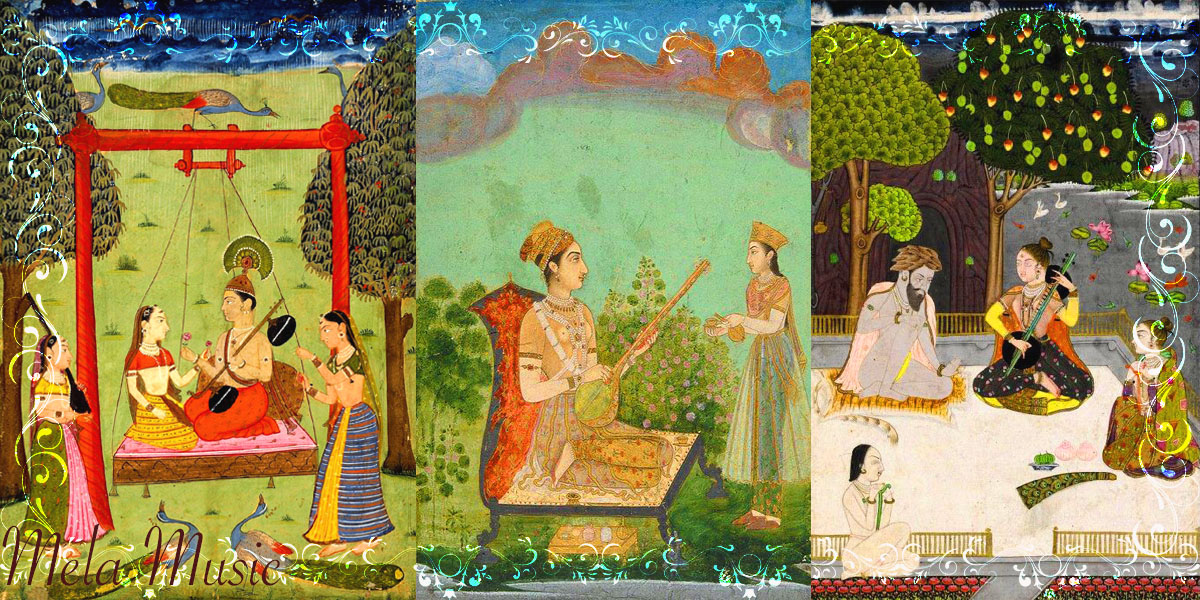
In Indian classical music, the term “jaati” refers to the classification of ragas based on the number of notes (swaras) used in their ascending (arohana) and descending (avarohana) scales. The concept of jaati helps in understanding the structure and complexity of a raga. There are several types of jaatis, which can be categorized based on the combination of notes in the arohana and avarohana. Here are the main jaatis:
Audav (Pentatonic)
Definition: A raga that uses five notes in both the ascending and descending scales.
Examples: Raga Bhupali, Raga Durga.
Aroha and Avaroha: S R G P D S’ / S’ D P G R S.
Shadav (Hexatonic)
Definition: A raga that uses six notes in both the ascending and descending scales.
Examples: Raga Marwa, Raga Gaud Sarang.
Arohana and Avaroha: S R G M P D S’ / S’ D P M G R S.
Sampurna (Heptatonic)
Definition: A raga that uses all seven notes in both the ascending and descending scales.
Examples: Raga Bilawal, Raga Yaman.
Arohana and Avaroha: S R G M P D N S’ / S’ N D P M G R S.
Audav-Shadav (Pentatonic-Hexatonic)
Definition: A raga that uses five notes in one direction (either ascending or descending) and six notes in the other.
Example: Raga Bairagi Bhairav (Audav aroha, Shadav avaroha).
Arohana and Avaroha: S R M P N S’ / S’ N D P M G R S.
Shadav-Sampurna (Hexatonic-Heptatonic)
Definition: A raga that uses six notes in one direction and seven notes in the other.
Examples: Raga Kedar (Shadav aroha, Sampurna avaroha).
Arohana and Avaroha: S M P N S’ / S’ N D P M G R S.
Audav-Sampurna (Pentatonic-Heptatonic)
Definition: A raga that uses five notes in one direction and seven notes in the other.
Examples: Raga Bageshree (Audav aroha, Sampurna avaroha).
Arohana and Avaroha: S G M D N S’ / S’ N D P M G R S.
Shadav-Audav (Hexatonic-Pentatonic)
Definition: A raga that uses six notes in one direction and five notes in the other.
Examples: Raga Desh (Shadav aroha, Audav avaroha).
Arohana and Avaroha: S R M P N S’ / S’ N D P M G S.
Sampurna-Audav (Heptatonic-Pentatonic)
Definition: A raga that uses seven notes in one direction and five notes in the other.
Examples: Raga Madhuvanti (Sampurna aroha, Audav avaroha).
Arohana and Avaroha: S R G M P D N S’ / S’ D P M G S.
Sampurna-Shadav (Heptatonic-Hexatonic)
Definition: A raga that uses seven notes in one direction and six notes in the other.
Example: Raga Jaijaivanti (Sampurna aroha, Shadav avaroha).
Arohana and Avaroha: S R G M P D N S’ / S’ N D P M G S.
Shadav-Sampurna (Hexatonic-Heptatonic)
Definition: A raga that uses six notes in one direction and seven notes in the other.
Examples: Raga Bhimpalasree (Shadav aroha, Sampurna avaroha).
Aroha and Avaroha: S G M P N S’ / S’ N D P M G R S.
These classifications help musicians and students understand the framework and constraints of each raga, allowing for proper rendition and improvisation within the raga’s structure.
Another aspect of jaati in raga classification pertains to the nature of the ragas themselves:
[a] Shudh Jaati – This category encompasses the original, unmixed ragas, representing their purest form.
[b] Chaayalag Jaati – Also known as salag jaati, these are ragas composed by blending the subtle shades of two distinct ragas, often retaining an influence of the shudh raga.
[c] Sankirna Jaati – These ragas amalgamate elements from several other ragas. For example, raga Adana combines Kanada, Megh, and Sarang.
In the domain of percussion and laya, jaati characterizes different rhythmic patterns:
[a] Teesra Jaati – Three beats contained within a single beat, or three beats within a four-beat laya section, where each beat constitutes ¾ or .75 of a beat. Essentially, three equal beats form a four-beat section.
[b] Chaturasra Jaati – Refers to the standard four-beat section in laya.
[c] Khanda Jaati – Five beats within a single beat, or five beats within a four-beat laya section, where each beat makes up .80 of a beat.
[d] Misra Jaati – Seven beats contained within a single beat, or seven beats within a four-beat laya section, with each beat constituting .57 of a beat.
[e] Sankirna Jaati – Nine beats contained within a single beat, or nine beats within a four-beat laya section, with each beat comprising .44 of a beat.
Content Provided By: Sangeetpedia
